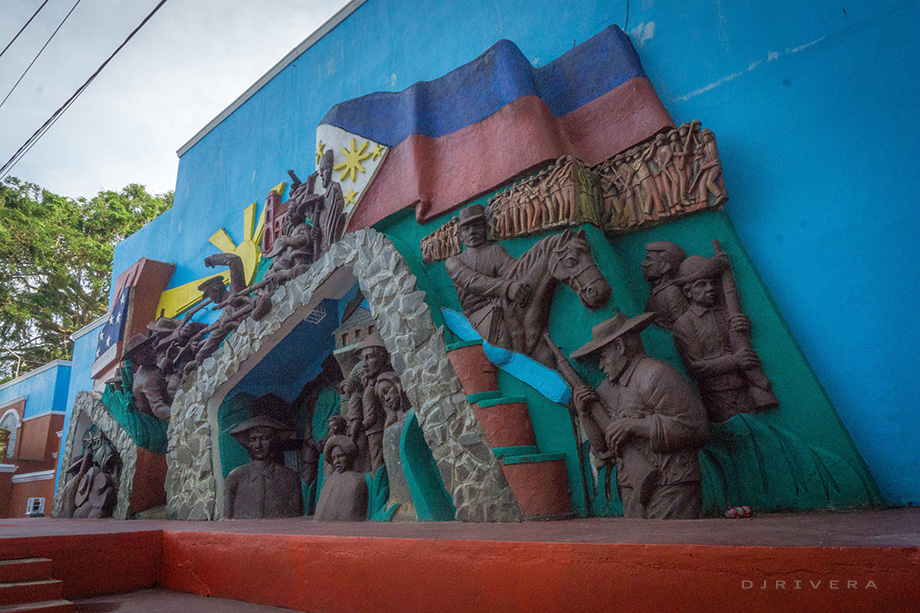 |
We left home at 7:30 AM, an hour and a half later than planned because of the early downpour. We were bidding to reach by bike the Spanish era church of Paete, Laguna from our home in Binangonan, Rizal.
At around noon we reached Mang Vic's Eatery situated in what seems to be the peak of the sloping and winding Manila East Road, near the municipal boundaries of Pililla, Rizal and Mabitac, Laguna. We would be finally out of Rizal province after five hours of grinding under a scorching mid-day sun. Mang Vic's and the surrounding vicinity seemed a popular pitstop for its scenic view. We stopped by for lunch.
The hours-long uphill ride consumed a great chunk of our day so, still 22 kilometers far, we decided to call Paete Church off for safety reasons—the winding Pililla-Mabitac road seemed treacherous at night. At Mang Vic's we took a breather and devise a new plan. That's when Mabitac came in, we googled what the bordering Laguna town has to offer.
A few meters down from Mang Vic's was the Mabitac Marker, that "I Love Mabitac" platform where by day bikers and motorcycle riders pile up for a photo. It was a bit crowded so we went past it and continue the next hour pedaling to Mabitac town center.
The Battle of Mabitac Mural
The mural is an eye-catching spot in the heart of the sleepy town center. With colors of the multi-colored Philippine flag dominating, it is so vivid that it was hard to miss. The high relief sculpture of historical scenes is a backdrop to a raised platform apparently used for important town events.
In September 17, 1900, Filipino revolutionaries led by Gen. Juan Cailles—he later served as provincial governor of Laguna for many years across several terms—emerged victorious over the American army in a bloody battle that took place at the entrance of the town from Siniloan. It was said that the Americans suffered 21 dead and 23 wounded soldiers while Filipino troops lost two, one of whom was Fidel Sario, an official in the revolution. The Battle of Mabitac Mural commemorates this significant victory in the Philippine-American War. The site's historical marker titled "Labanan sa Mabitac" was placed below the center platform.
Beside the mural is the path leading to the main entrance of the town's church known canonically as Nuestra Señora de Candelaria Parish Church. Mabitac Church is a church on a hill, the Battle of Mabitac Mural is at the foot of this hill.
Mabitac Church, A Church Above the Hill
Upon reaching the town center, the church's bell tower is the highest structure one will notice. Mabitac Church is perched on a hilltop that the townsfolk call kalbaryo. History recounts that the first church stood on a low-lying site in present-day Siniloan, the immediate neighboring town where Mabitac previously formed part of before becoming a separate town. Frequently ravaged by flood, the Franciscans transferred the church to its present site.
 |
The modest church façade possesses minimal details—three niches where images of male saints stand and, above the porch, a small, circular stained glass window with an image of the town patroness. The belfry was the only structure left from the original 17th century church. This difference in time period between the attached belfry and the rest of the façade becomes evident if one looks closely around the older bell tower. The church interior is relatively modern.
Inside the walls, the 17th century image of Our Lady of Candles stands at the lower portion of the bi-level retablo. The image has a long history, but the most notable is that Mabitac became an independent town owing to the insistence of the natives venerating the image.
At the center of the spacious church patio stands, facing the façade, a life-size image of St. Lorenzo Ruiz de Manila. Scattered around the church grounds are the Stations of the Cross where Catholic pilgrims pray during a Visita Iglesia.
And perhaps the most popular feature of Mabitac Church is the 126-step staircase that leads to the side entrance. It was said that the steps originally counted 96, structural improvements over the years increased it to its present count.
When we arrived there at around 3:00 PM, we had the church grounds all to ourselves. Church doors were also opened. The church overlooks the town backdropped by lush mountains on one side, and on the other, a vista of Laguna Lake. It was serene. A much-needed respite before we pedal back home. We would again brave the heart-pumping uphill of Mabitac and the heart-stopping downhill of Pililla but then, it was dark. A lengthy part of the avenue was pitch black.
We failed to reach the farther town of Paete, but we did not come home empty-handed with Mabitac. I brought home some history bites and a biking experience I surely won't forget.
References:
- Laguna Tourism Culture Arts and Trade Office. (2020, November 28). KASAYSAYAN NG MABITAC Dating nasasakupan ng Siniloan ang pamayanan ng Mabitac, at sinasabing itinatag ng mga paring Pransiskano ang pamayanan noong 1611 [Facebook status update]. Retrieved from https://www.facebook.com/1600831990199961/posts/kasaysayan-ng-mabitacdating-nasasakupan-ng-siniloan-ang-pamayanan-ng-mabitac-at-/2846615842288230/
- American History (n.d.). Battle of Mabitac 1900. Retrieved from https://american-history.net/19th-century-america/19th-century-wars-overview/philippine-american-war/battle-of-mabitac-1900/
- Republic of the Philippines - Stamps & Postal History. (2016, January 2). Church of Mabitac, Laguna, 4th Centenary. Retrieved http://www.philippinestamps.net/RP2016-Mabitac.htm
- Wikipedia. (n.d.). Governor of Laguna. Retrieved from https://en.wikipedia.org/wiki/Governor_of_Laguna#List_of_governors_of_Laguna











